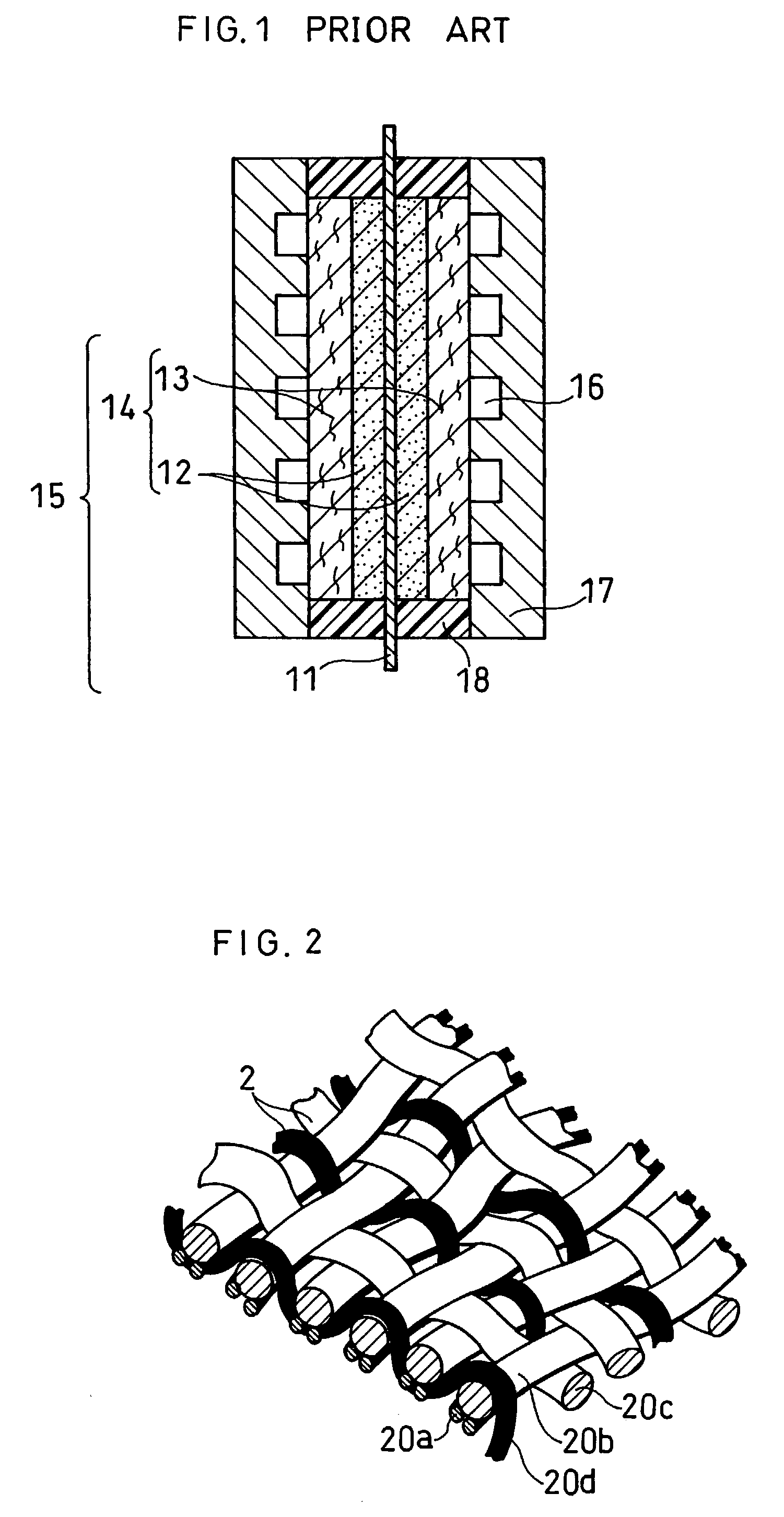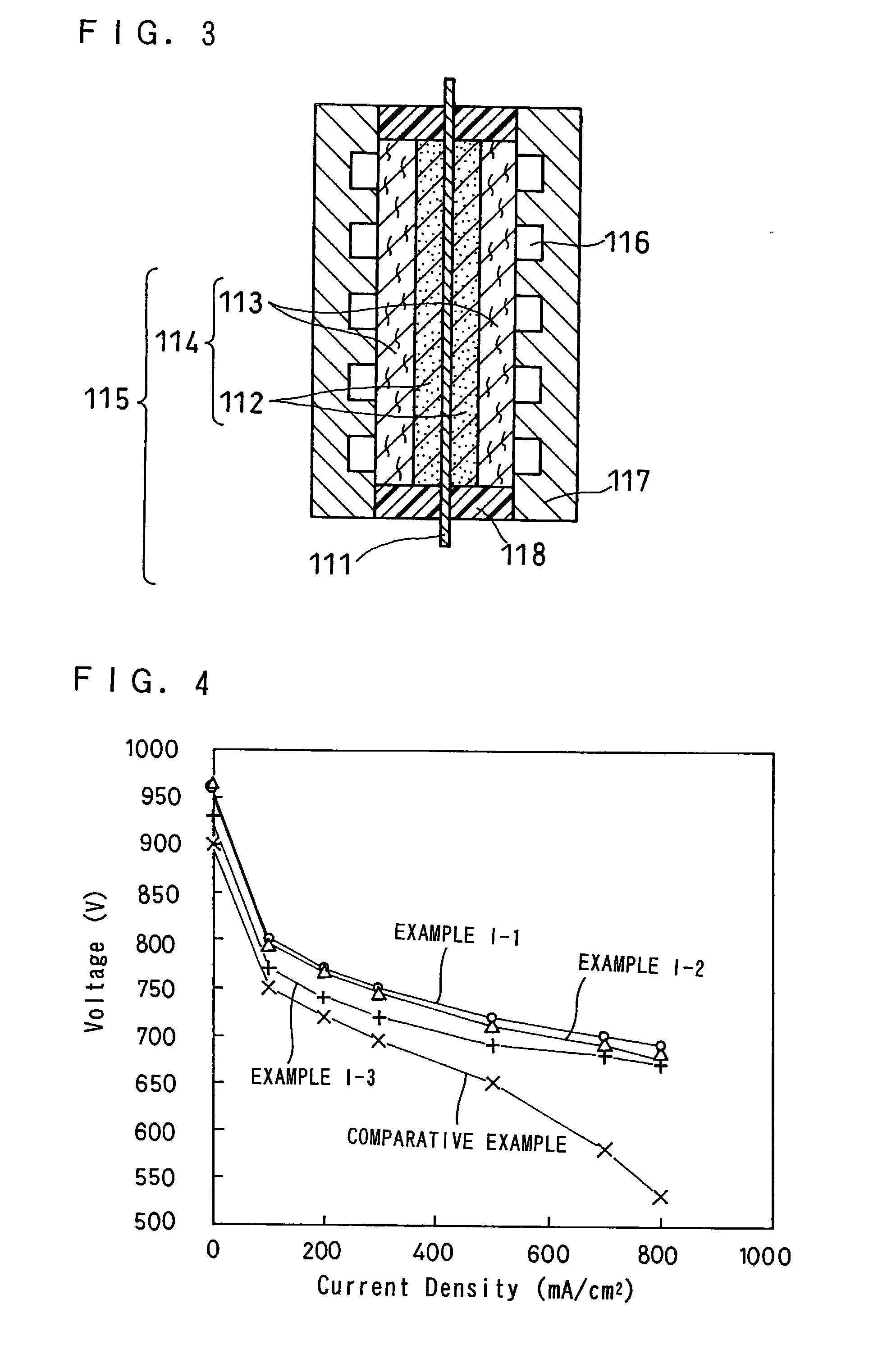Polymer electrolyte fuel cell
- Summary
- Abstract
- Description
- Claims
- Application Information
AI Technical Summary
Benefits of technology
Problems solved by technology
Method used
Image
Examples
example i-1
[0082]Firstly, as schematically shown in FIG. 2, a carbon cloth, having a finer mesh at the catalyst layer side thereof and a coarser mesh at the separator plate side thereof, was made as follows.
[0083]Threads each having a diameter of about 300 μm and made by stranding up PAN fibers having a diameter of about 10 μm was prepared as wefts 20a for a first layer. Likewise, threads each having a diameter of about 600 μm and made by stranding up PAN fibers having a diameter of about 10 μm was prepared as wefts 20b for a second layer. The threads having a diameter of about 600 μm were further used as warps 20c in the second layer to knit the wefts 20b of the second layer. Further, the threads having a diameter of about 300 μm were used as warps 20d to knit the wefts 20a, 20b of both the first layer and the second layer. Thereby, a cloth or precursor of carbon cloth 20 was made.
[0084]The thus made precursor of carbon cloth was heated to be graphitized at 2,000° C. in a nitrogen atmosphere ...
example i-2
[0095]A multi-layer carbon cloth 50 as schematically shown in FIG. 5 was made as follows. A first cloth was made by plain weave, using threads having a diameter of about 300 μm and having been made by stranding up PAN fibers having a diameter of about 10 μm. A second cloth was likewise made by plain weave, using threads having a diameter of about 600 μm and having been made by stranding up PAN fibers having a diameter of about 10 μm. The first cloth and the second cloth were then heated at 2,000° C. in a nitrogen atmosphere for 24 hours to get graphitized to be carbon cloths.
[0096]These carbon cloths were subjected to water repellent treatment in a manner similar to that described in EXAMPLE I-1, and the carbon cloth 50a made of the first cloth was stacked on the carbon cloth 50b made of the second cloth to be the multi-layer carbon cloth 50. FIG. 5 is an oblique view, partially in cross-section, of such multi-layer carbon cloth 50 seen from the second cloth side, schematically show...
example i-3
[0098]A single layer carbon cloth 60 as schematically shown in FIG. 6 was made as follows. A cloth was made by plain weave, using threads having a diameter of about 300 μm and having been made by stranding up PAN fibers having a diameter of about 10 μm, and also using threads having a diameter of about 600 μm and having been made by stranding up PAN fibers having a diameter of about 10 μm. More specifically, each 600 μm thread was placed for every consecutive three 300 μm threads for both the wefts and the warps, so that each 600 μm thread was placed between neighboring two groups of three consecutive threads as to both the weft arrangement and the warp arrangement as can be understood from FIG. 6. The thus made cloth was then heated at 2,000° C. in a nitrogen atmosphere for 24 hours to get graphitized to be the carbon cloth 60.
[0099]FIG. 6 is an oblique view, partially in cross-section, of such carbon cloth 60, schematically showing its structure. The thus made carbon cloth was sub...
PUM
 Login to View More
Login to View More Abstract
Description
Claims
Application Information
 Login to View More
Login to View More - R&D
- Intellectual Property
- Life Sciences
- Materials
- Tech Scout
- Unparalleled Data Quality
- Higher Quality Content
- 60% Fewer Hallucinations
Browse by: Latest US Patents, China's latest patents, Technical Efficacy Thesaurus, Application Domain, Technology Topic, Popular Technical Reports.
© 2025 PatSnap. All rights reserved.Legal|Privacy policy|Modern Slavery Act Transparency Statement|Sitemap|About US| Contact US: help@patsnap.com



